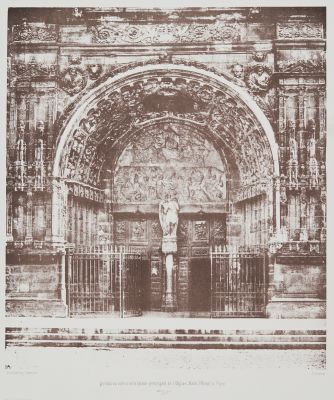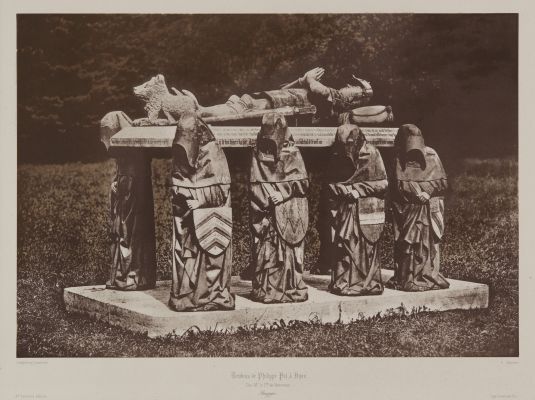
Title
Bas-relief provenant de l’ancienne Eglise Saint-Benigne de DijonArtist
Berthier, Paul Marcellin (likely) (French, 1822-1912)Publication
Voyages Pittoresques Et Romantiques Dans L'ancienne France: [bourgogne]Date
1863Process
Photolithograph (Poitevin process)Atelier
LemercierImage Size
18 x 36 cm
Baron Taylor’s Voyages pittoresques et romantiques dans I’ancienne France (1820-78) was planned as a record of the glories of France and, in particular, of those monuments that had survived the ravages of the Revolution a generation earlier. It could be described as a heritage publication ahead of its time. In its turn, it has become something of a monument in its own right, both to the Romantic attitude that inspired it and to the process of lithography by which it was realized. For those interested in tracing the history and progress of lithography, the Voyages pittoresques provides as complete a record as one could hope to find within the pages of a single publication – including it’s decline. Daguerre, who had already contributed drawings to the Voyages pittoresques and also subscribed to it, went a stage further. Two years later he announced his particular form of photography to the French nation. Almost immediately it achieved such success that unskilled amateurs could record their own Voyages pittoresques. A lithograph of Notre Dame de Paris, which claimed to have been the first made after a Daguerreotype, was published in the trade journal Le Lithographe in the very year of Daguerre s announcement. Taylor and Nodier even contributed text for one or the most important early collections of printed photographs: Excursions Daguerriennes. The temptation to use photography, however, at least openly, seems to have been resisted until the later volumes of the Voyages pittoresques. The threat to the lithographic draughtsman came when photographic images could be put on stone and printed lithographically. Experiments of this kind were being undertaken in Paris by the lithographer Lemercier, in association with Lerebours, Barreswil and Davanne, around the middle of the century. Subsequently, Poitevin developed a process of photolithography (patented in August 1855) which the lithographic printer Lemercier used under license for, among other publications, Voyages pittoresques. ln the Bourgogne volume (1863), twelve plates were printed by Lemercier using a photolithographic process. The rise and fall of the topographical lithograph in France can therefore be charted in this one publication. Even if Taylor had not died a year after the publication of Ancienne Normandie in 1878, it is doubtful whether his ambitious project, which was still far from complete, could have continued for much longer. By this time, both the means of recording the world through drawing and one of the most popular methods of printing images had changed almost beyond recognition. [1]
Taylor, Justin. Voyages Pittoresques Et Romantiques Dans L’ancienne France: [bourgogne]. Vol 9, Paris: A. F. Lemaître, 1863
Reproduced / Exhibited
Howe, Kathleen S. Intersections: Lithography, Photography, and the Traditions of Printmaking. Albuquerque: University of New Mexico Press, 1998. no. 18
Pygmalion Photographe, La sculpture devant la camera, 1844-1936, Musee d’Art et d’Histoire, Geneve, 1985, fig 60
References
[1] From: Fox, Peter. Cambridge University Library: The Great Collections. Cambridge, UK: Cambridge University Press, 1998. [The Voyages pittoresques et romantiques dans l’ancienne France / Michael Twyman] pp 90 – 106


